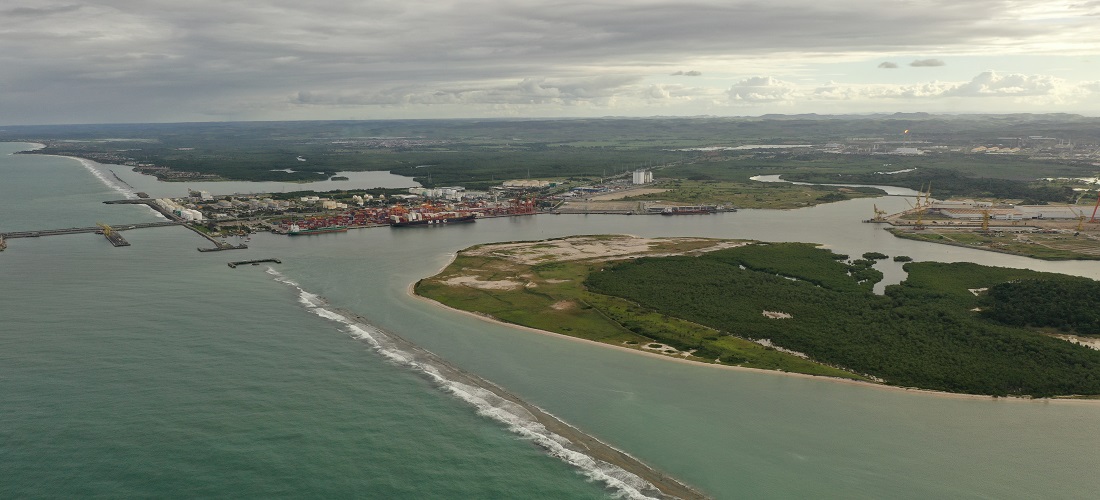
Port of Suape aims to have Brazil’s first green terminal by 2026
Oct, 20, 2023 Posted by Gabriel MalheirosWeek 202340
The country’s first “green’ container and general cargo terminal will commence operations in the second half of 2026 in the Suape Industrial Port Complex in Pernambuco. The facility will be constructed by APM Terminals, a subsidiary of A.P. Moller-Maersk, which recently signed an addendum to the concession contract for a 495,000 m² area.
APM Terminals will take over the property of the Atlântico Sul Shipyard (EAS). Present at the contract signing were Aristides Russi Junior, CEO of APM Terminals Suape; Marcio Guiot, CEO of the Suape Industrial Port Complex; Leo Huisman, Executive Director of APM Terminals for the Americas; Silvio Costa Filho, Minister of Ports and Airports; and Raquel Lyra, the Governor of Pernambuco.
APM Terminals Suape plans to commence construction of the terminal in 2024, with operations starting in the second quarter of 2026. The facility will have an initial capacity to handle 400,000 TEUs to serve the local market and act as a cargo hub for the Northeast and North regions, focusing on cabotage and long-haul routes. This will increase the port complex’s capacity by 55%.
The chart below compares containerized exports and imports at the Port of Suape between Jan 2019 and Aug 2023. The data is from DataLiner.
Imports & exports | Port of Suape | Jan 2019-Aug 2023 | TEU
Source: DataLiner (click here to request a demo)
“We have a lot of work ahead of us, and we are honored by the trust placed in our project, which will be the first 100% electrified terminal in Latin America and will receive an investment of R$1.6 billion in this first implementation phase,” said Russi Junior.
“All equipment will be electric, featuring cutting-edge technology and processes, such as a comprehensive environmental management system, waste management, wastewater treatment, and groundwater flow modeling for pollution control. It will also have its own 5G network, enabling real-time information transmission to clients 24/7,” explained the CEO of APM Terminals Suape.
Furthermore, the terminal will utilize remotely operated RTGs (rubber-tired gantry cranes), enhancing operational agility through remote control and positively impacting productivity and safety.
The executive also noted that APM would foster local socio-economic development, potentially attracting direct services to Asia and Europe.
“A positive ripple effect is expected, with cost and transportation price reductions increasing the competitiveness of exporters and reducing the prices of imported intermediate production inputs and consumer goods. Moreover, the terminal will positively impact retail and industry in the Northeast by expanding berthing windows for shipowners, encouraging increased vessel traffic and new services connecting Pernambuco to various ports worldwide.”
Port and Airport Minister Silvio Costa Filho emphasized the strategic importance of the new terminal. “Suape Port is the largest in the Northeast and among the top five in Brazil. It has undoubtedly evolved into an international hub. Development in our state, the Northeast, and Brazil cannot be discussed without considering the development of Suape. It’s an asset for our state, the Northeast, and Brazil.”
The Governor of Pernambuco also underscored that “the new investments will enhance Suape Port’s competitiveness and allow our state to reposition itself logistically for Brazil, domestically and internationally.”
Source: A Tribuna
To read the original text, please visit: https://www.atribuna.com.br/noticias/portomar/porto-de-suape-tera-primeiro-terminal-verde-do-pais-a-partir-de-2026
-
Shipping
Jul, 01, 2024
0
New fuel restrictions for ships in Arctic fall short, green groups say
-
Other Cargo
Dec, 09, 2024
0
Federal Revenue Seizes 221 kg of Cocaine at the Port of Santos
-
Economy
Mar, 27, 2023
0
Global trade slows, but ‘Green Goods’ grow: UNCTAD
-
Economy
Dec, 01, 2023
0
Brazil: shipments of halal products expected to grow 10% in 2024



